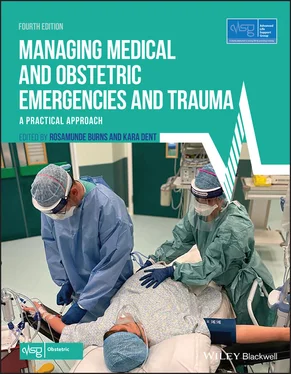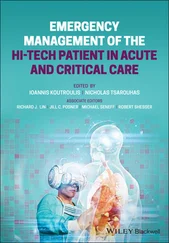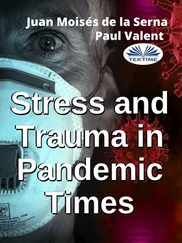Pulse oximetry
Heart rate/electrocardiogram (ECG)
Blood pressure
Respiratory rate
End‐tidal CO2 monitoring is appropriate in an intubated patient
Urine output: as a measure of adequate perfusion and fluid resuscitation
Fetal heart monitoring will reflect the haemodynamic status of the mother until a circulation problem is addressed as part of the primary survey and as such provides information on the adequacy of maternal resuscitation in the primary survey
The pulse oximeter limitations are that the patient must be well perfused to obtain a reading. Ambient light and dyes, such as nail polish or circulating methaemoglobin, can cause erroneous readings. A fall in oxygen saturation is a late sign of an airway, breathing or circulation problem.
Blood tests (full blood count, blood group and save, venous blood gas, urea and electrolytes, thromboelastography, Kleihauer)
Essential radiographs during the primary survey and resuscitation are chest and pelvis
FAST (focused assessment with sonography for trauma) scan
Assess fetal well‐being and viability
Use ultrasound to:
Detect fetal heart and check rate
Ascertain the number of fetuses and their positions
Locate the position of the placenta and the amount of liquor
Look for retroplacental bleeding and haematoma
Detect an abnormal position of the fetus and free fluid in the abdominal cavity, suggesting rupture of the uterus
Detect damage to other structures
Check for free fluid and blood in the abdominal cavity
Adequately resuscitating the mother will improve the outcome for the fetus.
Definitive care takes place under the supervision of relevant specialists. It is of utmost importance to the patient’s continued quality of life.
A systematic approach of primary survey (simultaneous assessment and resuscitation), fetal assessment, secondary survey and definitive care enables the clinician to give the best patient care possible in complex situations.
CHAPTER 4 Human factors
Learning outcomes
After reading this chapter, you will be able to:
Describe how human factors affect the performance of individuals and teams in the healthcare environment
The emphasis on the management of obstetric urgent or emergency care has traditionally concentrated on knowledge and application of the appropriate technical skills for the given situation. An often overlooked element is how in these high‐pressure situations, maternity staff from several disciplines can come together to form an effective team that minimises error and works actively to prevent adverse events to minimise patient harm The maternity team in acute emergencies is made up of medical staff from different specialties and of varying seniority, midwives and ancillary staff (including healthcare assistants, operating department assistants, scrub nurses, etc.). The hospital‐based maternity team also relies on close links with laboratory and imaging teams during emergencies, as well as support from administrative teams (ward clerks, hospital switchboard) and portering services. This is a complex system and requires knowledge of human factors and team working. The role of simulation and training as promoted within the mMOET course is vital in improving how individuals will work within their own teams during obstetric emergencies.
This chapter provides a brief introduction to some of the human factors that can affect the performance of individuals and teams in the healthcare environment. Human factors, also referred to as ergonomics, is an established scientific discipline and clinical human factors has been described as:
Enhancing clinical performance through an understanding of the effects of teamwork, tasks, equipment, workspace, culture and organisation on human behaviour and abilities and application of that knowledge in clinical settings
(Kohn et al., 2010).
4.2 Extent of healthcare error
In 2000 an influential report entitled To Err is Human: Building a Safer Health System (Kohn et al., 2010) suggested that across the USA somewhere between 44 000 and 98 000 deaths each year could be attributed to medical error. A pilot study in the UK demonstrated that approximately 1 in 10 patients admitted to healthcare experienced an adverse event.
Healthcare has been able to learn from a number of other high‐risk industries including the nuclear, petrochemical, space exploration, military and aviation industries about how team issues have been managed. These lessons have been slowly adopted and translated to healthcare.
Specialist working groups and national bodies have been instrumental in promoting awareness of the importance of human factors in healthcare. They aim to raise awareness and promote the principles and practices of human factors, identify current human factor activity, capability and barriers, and create conditions to support human factors being embedded at a local level. One such example of this in the UK is the Human Factors Clinical Working Group and the National Quality Board’s concordat statement on human factors.
4.3 Causes of healthcare error
Consider this example of an adverse event:
A woman in labour needs to receive an infusion of a particular drug to manage severe hypertension. An error occurs and she receives an incorrect dose of the drug. What are the potential causes of this situation?
| Potential causes of our example drug error |
| Prescription error |
Wrong drug prescribed |
| Preparation error |
Correct drug prescribed but misread |
| Preparation error |
Contents mislabelled during manufacture |
| Drawing up error |
Incorrect drug selected |
| Administration error |
Patient ID mix‐up, drug given to wrong patient |
Q. What one thing links all of these errors?
A. The humans involved – these are all examples of human errors.
Humans make mistakes. No amount of checks and procedures will mitigate this fact. In fact the only way to completely remove human error is to remove all the humans involved. It is vital therefore that we look to work in a way that, wherever possible, minimises the occurrence of mistakes and ensures that when they do occur the method minimises the chance of the error resulting in an adverse event.
It has been suggested that these human errors can be further categorised into: (i) those that occur at the sharp end of care by the treating team and individuals; and (ii) those that occur at the blunt or organisational level, typically through policies, procedures, staffing and culture. These errors can be further subdivided ( Table 4.1).
Table 4.1 Types of errors
|
|
Explanation |
Example |
| Sharp errors that occur with the team/individuals treating the patient |
Mistake |
Lack or misapplication of knowledge |
Not knowing the correct drug to prescribe |
| Slip or lapse |
Skills‐based mistake |
Knowing the correct drug but writing another one |
| Violation |
Deliberate action that may be routine or exceptional |
Not attempting to get a drug second checked as there are no staff available |
| Blunt/organisational errors |
|
Policies, procedures, infrastructure and building layout that has errors embedded |
Different drugs used by different specialties and departments for same condition |
It is typically found that the latent/organisational issues often coexist with the sharp errors; in fact it is rare for an isolated error to occur – often there is a chain of events that results in the adverse event. The ‘Swiss cheese’ model demonstrates how apparently random, unconnected events and organisational decisions can all make errors more likely ( Figure 4.1). Conversely, a standardised system with good defences can capture these errors and prevent adverse events.
Читать дальше












